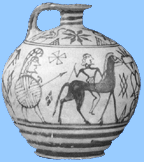The Legend of the Great Horse traces horsemanship from its earliest beginnings. The premise of the story is that Meagan, a horse-interested teenager of modern day, is whisked back in time to relive history … on horseback. As she travels in “jumps” from the earliest days of man’s association with horses, Meagan and the reader experience the changes in horsemanship that mirrored the advance of civilization.
A hallmark of skilled modern riding is that it looks “easy,” but it has not always been this way. The casual spectator watching well-groomed horses cantering a jumping field or half-passing down the centerline may be forgiven believing things such as “the horse is doing all the work” or “anyone could do it” etc. Riding looks easy when done well because the rider remains in balance with the horse, maintaining a fluid rhythm with the mount’s athletic motion. This is not how horsemanship has looked through most of history, and nothing we now take for granted about riding was obvious or simple for humans to discover.
The origins of horseback riding are lost in the mists of time, but using the horse to pull wagons, carts and chariots represented the first phase of practical horsemanship. Mounted horsemanship does not appear in clear view until antiquity, and after at least 3000 years of development it wasn’t terribly impressive. The horses were guided with nose-rings by a rider who sat far back toward the horse’s hindquarters, though the Greeks modified this by inching forward to sit on the middle of the horse’s back. It literally took the human race thousands of years to discover where, exactly, to properly sit on horseback.
To humans, horses possess an alien mind, and what seems obvious today was not “obvious” at all. As one example, stirrups were not invented until after the fall of the Roman Empire—which itself was more than 25,000 years from the days that prehistoric man’s preoccupation with the animal was shown by painting in caves. First came a “toe loop” which developed in India (c. 500BC) for the holding of the rider’s big toe. A few centuries later nomadic “Sarmatians” of southern Russia and the Balkans invented a single stirrup for use in mounting. Over the next half-millennium, Asia brought the stirrup to fruition; it was copied by Europeans and revolutionized war.
One might consider that our ancestors were not the most clever ponies in the stable, but the reason for the long period of development was that advanced horsemanship required changes in mankind’s thinking. As humanity grew sufficient empathy to discover advanced horsemanship, the modern world also began a rapid transformation into the modern age.


